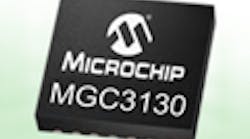GestIC technology utilises thin sensing electrodes made of any conductive material, such as printed-circuit-board traces or an indium-tin-oxide (ITO) coating, to allow for invisible integration behind the device’s housing. The technology provides 100% surface coverage, eliminating angle-of-view blind spots found in other technologies. Detection range is up to 15 cm, with 150-DPI (mouse-like) resolution, and a 200Hz sampling rate to sense even the fastest hand and finger motions.
An on-chip library of gestures, called the Colibri Suite, is the driving force behind the high gesture-recognition rates of GestIC technology. The library combines a stochastic Hidden Markov model and x/y/z hand position vectors to provide a reliable set of recognised 3D hand and finger gestures. Examples include Wake-Up on Approach, Position Tracking, Flick Gestures, Circle Gestures, and Symbol Gestures to perform functions such as on/off, open application, point, click, zoom, scroll, free-space mouse-over, and many others. The chip also is flexible enough to use pre-filtered electrode signals for additional functionality.
Microchip’s Sabrewing MGC3130 Single Zone Evaluation Kit is available now with a selectable electrode size of 5 or 7 inches; it comes with the Colibri Suite library and a GUI.
Microchip